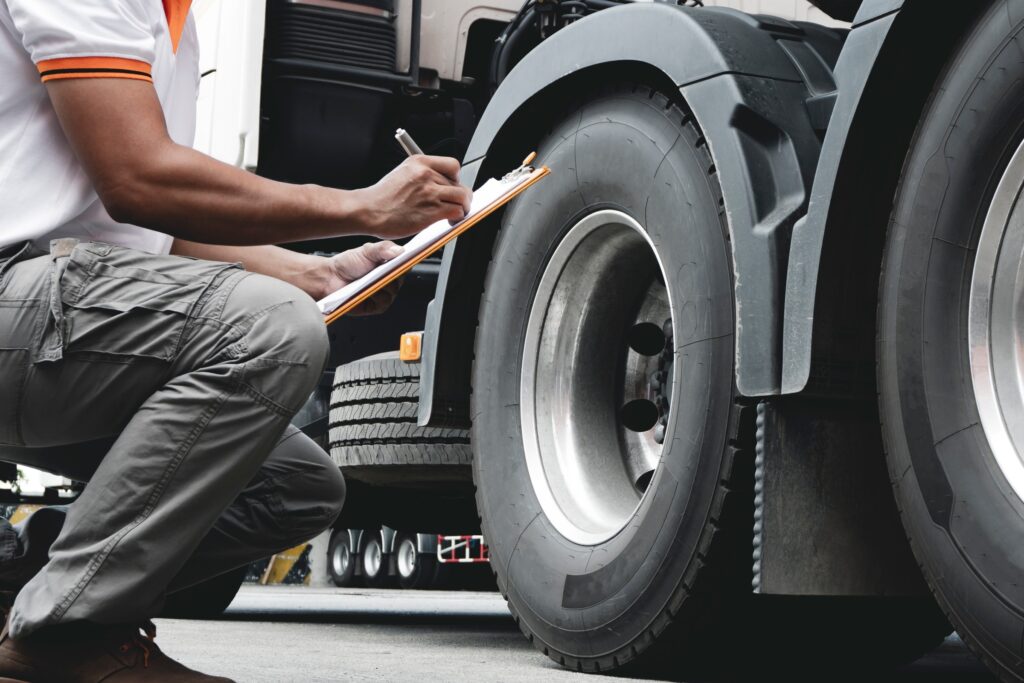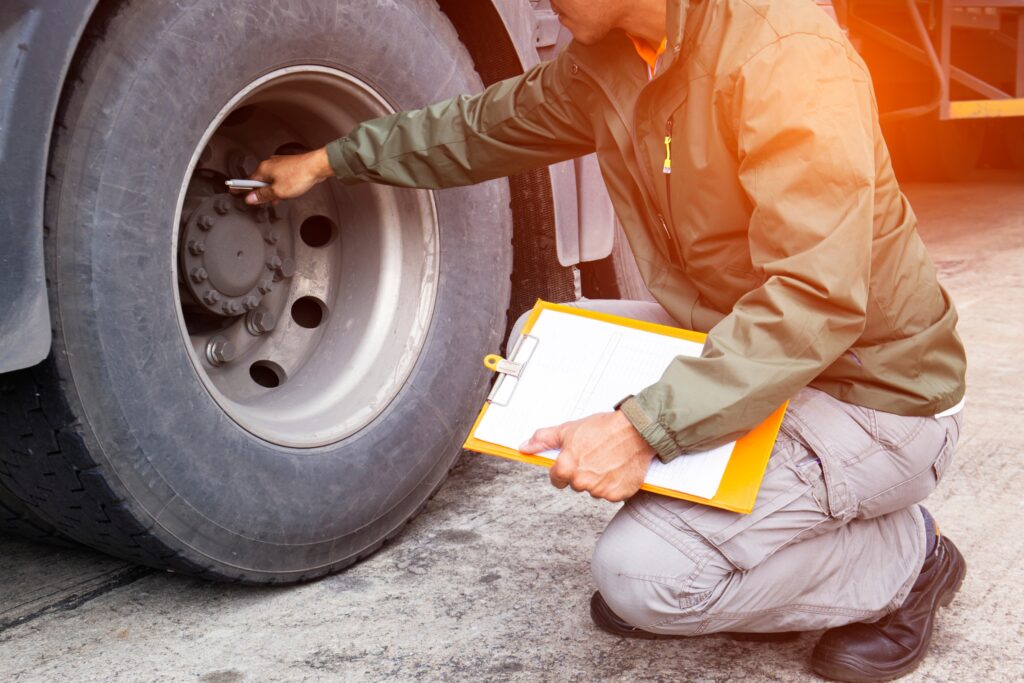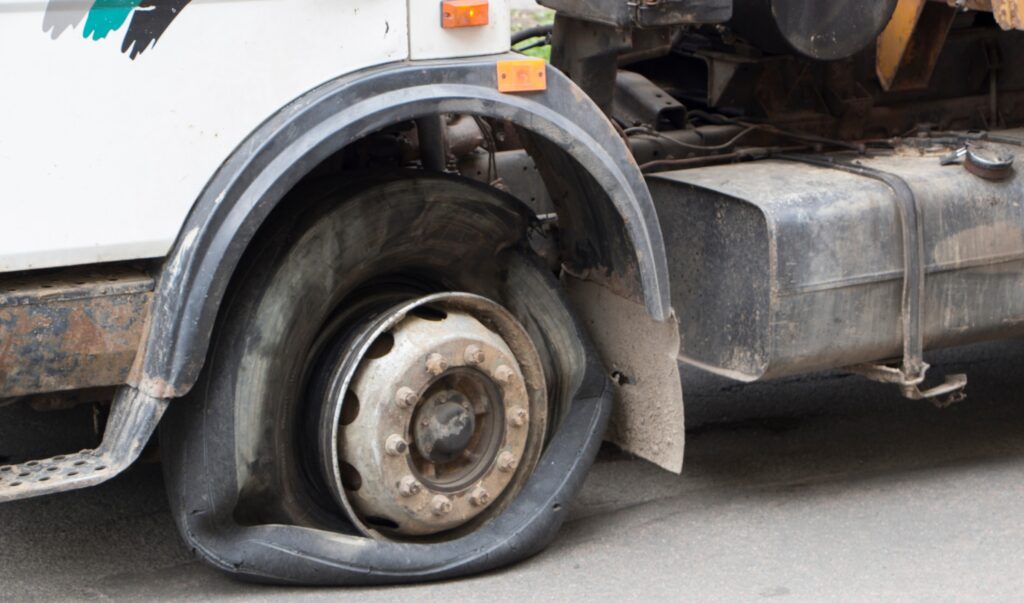What is the Right Tire Pressure for Semi-Truck Tires?

Maintaining the right tire pressure is a critical aspect of a truck driver’s daily responsibilities. Not only does it ensure safety on the road, but it also impacts fuel efficiency, vehicle performance, and overall tire lifespan. For drivers at Barr-Nunn Transportation, this knowledge is essential for smooth operations. In this article, we’ll dive into the importance of proper tire pressure, the right PSI for semi-truck tires, and how to avoid the common pitfalls of over- or under-inflation.
Tire Pressure for Truck Drivers
Proper tire pressure plays a pivotal role in the day-to-day safety and performance of semi-trucks. It influences how a truck handles on different terrains, how stable it feels under varying loads, and even how long the tires last. Maintaining correct tire inflation improves grip, allows for better braking, and reduces the likelihood of dangerous blowouts. From a financial perspective, properly inflated tires can also significantly reduce fuel costs, a factor every driver is conscious of when logging long miles across the country.
Tire longevity is another factor to consider. The correct air pressure ensures even tread wear, which helps prevent premature replacement. For companies like Barr-Nunn, keeping tires in optimal condition directly translates to more operational efficiency, and fewer roadside emergencies. Drivers who stay on top of their tire pressure will experience fewer unexpected issues, allowing them to focus on their job.
The Importance of Tire Pressure in Semi-Trucks
Tire pressure is critical for semi-trucks due to the unique demands placed on these vehicles. Unlike passenger cars, semi-trucks carry much heavier loads, often traveling thousands of miles across a variety of road conditions. The right tire pressure ensures that the truck’s handling is optimal, which is key for safety when dealing with steep inclines, sharp turns, or heavy braking.
With proper inflation, a truck will also experience better stability. Inadequate pressure can make the truck difficult to control, especially when fully loaded, putting the driver at risk. Moreover, incorrect tire pressure can affect the smoothness of the ride and cause discomfort for long-distance drivers.
Understanding PSI: What Does It Mean?
PSI, or pounds per square inch, measures the air pressure inside your tires. For semi-truck drivers, understanding PSI is essential because it dictates how efficiently the truck operates. Passenger vehicles typically require lower PSI levels, but semi-truck tires often demand pressures of up to 100 PSI or more, depending on the tire’s load rating and manufacturer specifications.
Correct tire pressure depends on various factors, including load weight, road conditions, and temperature. It’s critical to check the manufacturer’s recommendations for each specific tire, as the wrong PSI could lead to dangerous outcomes.
Recommended Tire Pressure for Semi-Truck Tires
Industry standards typically recommend a tire pressure range between 90 and 120 PSI for semi-trucks. However, the exact PSI for each tire should match the manufacturer’s guidelines and consider the load being carried. For instance, when fully loaded, a truck may need its tires inflated to the higher end of this range.
It’s also worth noting that different brands of tires might have slightly different recommendations, so it’s important to check the sidewall of the tire or consult the tire’s manual for the specific PSI range. Additionally, Barr-Nunn Transportation drivers should regularly consult company protocols on tire pressure to align with safety and efficiency standards.
Factors That Influence Tire Pressure
Several factors can affect tire pressure, which means that it might fluctuate throughout the day or across different routes:
- Load Weight: The heavier the load, the higher the tire pressure should be to ensure proper distribution across the vehicle.
- Temperature Changes: Tires lose approximately 1 PSI for every 10°F drop in temperature, and the opposite happens in hot weather, where pressure increases.
- Road Conditions: Rough, uneven, or poorly maintained roads can impact tire wear, making regular checks essential.
- Tire Type: Specific tires are designed for different conditions (off-road vs. highway), and each type has unique PSI requirements.
The Effects of Over-Inflated Tires
While some drivers might think that inflating tires beyond the recommended PSI will provide better fuel efficiency, over-inflated tires can actually reduce traction and make it harder to control the truck. Excessive air pressure also causes the tires to wear unevenly, particularly in the center of the tread. This premature wear can lead to blowouts, especially under heavy loads, which is a serious safety risk on the road.
The Effects of Under-Inflated Tires
On the other hand, under-inflated tires are equally hazardous. They create increased rolling resistance, making the engine work harder to move the truck, which negatively impacts fuel efficiency. Additionally, under-inflation causes more wear on the tire’s edges, leading to a higher risk of blowouts. In fact, a significant number of tire blowouts are directly related to low tire pressure, making it crucial for truck drivers to regularly monitor and adjust their tire pressure.
Tire Pressure for Different Weather Conditions
Weather can dramatically impact tire pressure. In colder climates, air molecules contract, lowering tire pressure, while heat causes the air to expand, increasing pressure. Therefore, drivers must be vigilant about checking tire pressure during both hot summers and cold winters. In regions like the northeastern U.S., where temperatures can vary significantly, adjustments should be made based on the seasonal changes to maintain optimal tire performance.
Temperature’s Impact on Tire Pressure
Temperature plays a critical role in tire pressure fluctuations. As a rule of thumb, for every 10°F increase, tire pressure goes up by about 1 PSI, and vice versa. Drivers should account for this when traveling through areas with varying climates, such as mountainous regions in the eastern U.S., where temperatures can shift dramatically in short distances.

How Often Should Semi Truck Tire Pressure Be Checked?
Regular tire pressure checks are essential for preventing issues before they become serious problems. It’s recommended that drivers check tire pressure at least once a day, ideally before starting their shift. This helps identify any slow leaks or variations in PSI caused by temperature changes. Additionally, it’s important to check the tires again after long hauls, especially if the truck has traveled through regions with drastic climate differences.
Best Tools for Monitoring Tire Pressure
Two key tools for monitoring tire pressure are the manual tire pressure gauge and the Tire Pressure Monitoring System (TPMS). While a basic tire gauge can give an accurate reading on the spot, TPMS devices provide continuous updates about the tire’s pressure in real time. Barr-Nunn Transportation trucks come equipped with TPMS on all trailers, making it easier for drivers to monitor tire pressure without manual checks during a haul.
How to Manually Check Tire Pressure
To manually check tire pressure, follow these steps:
- Gather Equipment: You’ll need a reliable tire pressure gauge.
- Remove the Valve Cap: Locate the valve stem on the tire and remove the cap.
- Use the Gauge: Press the gauge onto the valve stem and wait for the reading.
- Compare to Recommended PSI: Check the tire’s PSI and compare it with the manufacturer’s recommendation.
- Adjust Pressure as Needed: Inflate or deflate the tire to meet the correct PSI.
Signs of Improper Tire Pressure
There are several warning signs that may indicate improper tire pressure:
- Uneven Tire Wear: Worn tire edges or centers can signal low or high pressure.
- Poor Handling: The truck may feel sluggish or harder to control, especially in turns or when braking.
- Increased Fuel Consumption: A sudden spike in fuel usage could be related to under-inflated tires.
- Vibration in the Steering Wheel: Uneven tire pressure can cause the truck to shake, leading to discomfort and handling issues.
How Incorrect Tire Pressure Impacts Fuel Economy
Fuel economy is one of the biggest reasons to maintain proper tire pressure. Under-inflated tires increase rolling resistance, making the truck consume more fuel to maintain speed. Over time, this can add up to significant costs for both individual drivers and companies like Barr-Nunn. By keeping tires properly inflated, drivers can expect better fuel efficiency, saving thousands of dollars in fuel expenses over the life of the truck.
Legal Requirements for Semi-Truck Tire Pressure
The Federal Motor Carrier Safety Administration (FMCSA) requires that all commercial trucks meet specific tire pressure regulations. Drivers are responsible for ensuring that their tires are properly inflated according to both federal and state laws. Additionally, compliance with these regulations is crucial for passing safety inspections and avoiding fines.
Tire Pressure and Load Distribution
Even load distribution is essential to maintaining proper tire pressure. Unevenly loaded trucks place excessive strain on certain tires, leading to under-inflation or over-inflation issues. Drivers should regularly inspect how weight is distributed on their truck to ensure that no one tire is bearing more load than others.
How Tire Pressure Affects Truck Safety
Improper tire pressure can be a silent threat to truck safety. Under-inflation or over-inflation can lead to tire blowouts, which are hazardous at high speeds. Moreover, poor tire pressure affects braking efficiency, making it harder to stop the truck in time. For Barr-Nunn Transportation drivers, maintaining proper tire pressure is key to keeping both the driver and the cargo safe.

How to Avoid Tire Blowouts
Preventing blowouts starts with regular tire inspections and pressure checks. Drivers should make it a habit to inspect tires for signs of wear, maintain the proper PSI, and avoid overloading the truck. Keeping an eye on road conditions and avoiding potholes or rough terrain can also minimize the risk of a blowout.
Technology Solutions for Maintaining Tire Pressure
Technology has revolutionized tire maintenance with systems like automatic tire inflation (ATI) and advanced TPMS. ATI systems automatically adjust tire pressure as needed, while TPMS provides real-time pressure readings. These tools can help drivers stay on top of tire maintenance without frequent manual checks.
The Cost of Improper Tire Maintenance
Neglecting tire pressure maintenance can lead to costly consequences. Tire blowouts not only result in the need for immediate replacement but can also cause damage to other parts of the truck and require costly roadside assistance. Furthermore, under-inflated tires reduce fuel efficiency, resulting in long-term fuel expenses that could have been avoided.
What to Do in Case of a Tire Blowout
In the event of a tire blowout, follow these steps:
- Remain Calm: Keep a firm grip on the steering wheel and avoid sudden movements.
- Decelerate Slowly: Ease off the accelerator but don’t slam on the brakes.
- Pull Over Safely: Find a safe spot to stop and turn on your hazard lights.
- Inspect the Damage: Check the tire and call for assistance if necessary.
Tire Maintenance Best Practices
In addition to maintaining proper tire pressure, drivers should regularly rotate their tires, inspect them for wear, and ensure they are aligned. These practices help extend tire life and ensure that the truck handles smoothly on the road.
How Barr-Nunn Transportation Supports Tire Maintenance
At Barr-Nunn Transportation, safety and efficiency are top priorities. The company ensures that all trailers are equipped with TPMS, allowing drivers to monitor tire pressure in real time. Additionally, Barr-Nunn provides comprehensive maintenance support to ensure that drivers are equipped with the tools and knowledge necessary to keep their trucks in optimal condition.
The Role of Proper Tire Pressure in Reducing Carbon Emissions
Maintaining proper tire pressure doesn’t just save money; it also reduces the truck’s carbon footprint. Under-inflated tires cause the engine to work harder, burning more fuel and emitting more CO2. By keeping tires properly inflated, drivers can reduce fuel consumption and contribute to a greener environment.
Common Tire Pressure Myths in Trucking
Several myths persist about tire pressure in trucking, such as the belief that higher pressure always leads to better fuel efficiency. In reality, over-inflated tires can be just as dangerous as under-inflated ones. Another common misconception is that visual inspection alone is enough to determine if a tire is properly inflated, which is rarely the case. Always use a tire gauge or TPMS for accurate readings.
Conclusion
Proper tire pressure is an essential aspect of maintaining safety, fuel efficiency, and tire longevity for semi-truck drivers. By following best practices for tire maintenance and utilizing modern technology like TPMS, drivers can reduce the risk of blowouts, improve fuel economy, and ensure their trucks remain roadworthy. At Barr-Nunn Transportation, we support our drivers in maintaining optimal tire pressure, helping them stay safe on the road and operate efficiently.